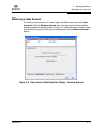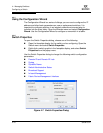
4 – Managing Switches
Configuring a Switch
59234-03 A 4-19
A
4.6.2.7
Fabric Device Management Interface
Fabric Device Management Interface (FDMI) provides a means to gather and
display device information from the fabric, and allows FDMI capable devices to
register certain information with the fabric, if FDMI is enabled. QuickTools will
report any and all FDMI information reported by the entry switch, if FDMI is
enabled on the entry switch. To view FDMI data, FDMI must be enabled on the
entry switch and on all other switches in the fabric which are to report FDMI data.
FDMI is comprised of the fabric-to-device interface and the application-to-fabric
interface. The fabric-to-device interface enables a device’s management
information to be registered. The application-to-fabric interface provides the
framework by which an application obtains device information from the fabric. Use
the FDMI HBA Entry Limit field on the Switch Properties dialog to configure the
maximum number of HBAs that can be registered with a switch. If the number of
HBAs exceeds the maximum number, the FDMI information for those HBAs can
not be registered.
Use the FDMI Enabled option on the Switch Properties dialog to enable or disable
FDMI. If FDMI is enabled on an HBA, the HBA forwards information about itself to
the switch when the HBA logs into the switch. If FDMI is enabled on a switch, the
switch stores the HBA information in its FDMI database. Disabling FDMI on a
switch clears the FDMI database. If you disable FDMI on a switch, then re-enable
it, you must reset the ports to cause the HBAs to log in again, and thus forward
HBA information to the switch.
To view detailed FDMI information for a device, click the Devices tab, and click
the Information (i) button in the Details column of the Devices data window. The
Detailed Devices Display dialog displays the specific information for that device.
Refer to ”Devices Data Window” on page 3-8 for more information.


















